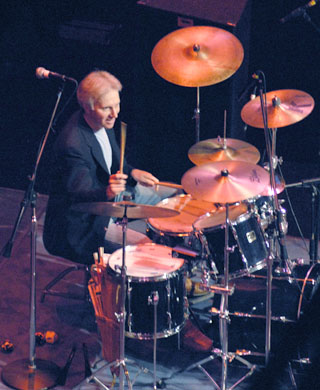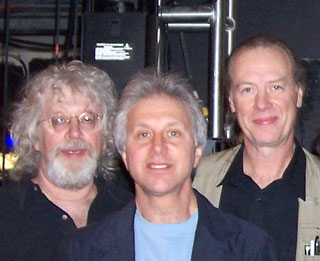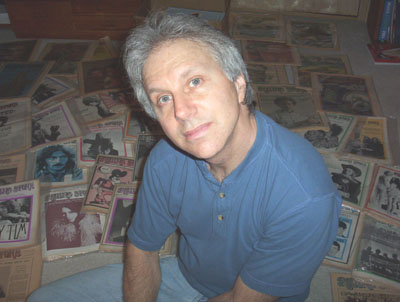Inside
the
Summer Issue:
Harry
Chapin’s
“Ripple” of Influence
Grows Every Day
Jen Chapin Leads Us
On A Lushly-Written
Journey Into Her Life
In “Ready”
WHY Takes Holistic
Approach to Fight
Hunger & Poverty
DMC’s New Disc
Strikes Many Chords
Hard Rock Café
Serves Up Benefit CD
to Fight Hunger
When Howie Met Harry:
Catching Up With
Drummer Howard Fields
Performing Artist
Inspires Audiences
Through Prose
Celestial Cross-Pollination
Yields a Harry Chapin-
Dante Anthology of
Student Essays
Amish Farmers’ Co-op
Finds Innovation in
Simpler Ways
Still Wild About Harry
Behind
the CD “Cause”
Do Something!
Click
below
to read previous
issues of Circle!
When
Howie Met Harry: Catching Up
With Drummer Howard Fields
by Linda Swanson
 |
| Howard Fields teaches drums, piano, and guitar in a comfortable studio within his Bergenfield, NJ, home. |
When drummer
Howard Fields met Harry Chapin in 1974, he already knew of Harry’s
hit songs including, Cat’s in the Cradle, Taxi, and W*O*L*D.
“I was playing in a band in Brooklyn with a guitar player named Doug
Walker, an old friend of the Chapins," he recalled.
“Doug had met them when he was singing in the Grace Church Choir
where Harry’s brothers Tom and Steve sang and where Harry also sang
for a short time. In 1974 Steve Chapin called Doug to tell him there was
going to be a Broadway show Based on Harry’s music. Harry asked Doug
to play in it and asked him to recommend a drummer so Doug recommended
me. That’s how it started," he recalled.
They first met face to face at a rehearsal for The Night That Made
America Famous. “He was friendly, not overwhelmingly friendly,
but friendly,” Fields said.
At the time Fields was just out of college and didn’t have much money.
“I had to join the musician’s union, and he fronted me the money.”
Fields said he paid Harry back as soon as he got paid by the show. “But
I remember that. He was a nice guy.”
The Night That Made America Famous had a disappointingly short
run from February 26, 1975, to April 6, 1975. “It was what I’ve
referred to as a howling failure. Six weeks was not very impressive by
Broadway standards, but the closing of the show was the best thing that
could have happened to me and a few of the other people involved,”
he said.
At that point Harry decided to augment his previously small touring band,
which until 1975 was Harry on guitar, John Wallace on bass, Ron Palmer
on guitar, and cellist Tim Scott followed by Michael Masters.
"When the Broadway show folded, and with a taste of what it was like to
play with a bigger and more electric band, he added me on drums, Steve
Chapin on keyboard, Tom Chapin on guitar, and guitarist Doug Walker, who
replaced Ron Palmer,” he recalled. “It was great playing on
Broadway, but this is what we really wanted to do: play real concerts
all around the world.”
Fields said Harry loved performing on Broadway. “So I think it was
a bittersweet thing for him. He wasn’t thrilled with the show closing,
but I think hitting the road again made him happy as well.”
In the ensuing seven years, Fields played more than 900 shows world-wide
with Harry. In addition, there were TV appearances on The Midnight
Special, Don Kirshner’s Rock Concert, The Tonight Show,
The Mike Douglas Show, and The Merv Griffin Show. During
Fields’ time with Harry, he recorded six LPs, including the platinum
album, Greatest Stories Live.
Fields got to know Harry well and said that although he was sometimes
difficult to deal with, Harry remains in his memory as a warm, likable
guy.
“Some of the best moments and best memories of my life were hanging
out on the road with the band -- Steve, John, Doug and Kim Scholes (Michael
Masters’ replacement), who was the cellist for most of my time in
the band," he said. Harry, however, didn’t have very much time to
hang out because he had so many other things going on, Fields explained.
“He had no spare time. Every minute of the day was regimented. Very
often he flew home for just a few hours if he could."
“I miss those days, the special relationship that band members have
when they are steadily working on the road for 250-300 days a year. I
don’t miss the actual traveling, though, or dealing with all the
inconveniences, what goes on inside the airports, getting to and from
the hotel. That was very tough."
Came One Dark July
On the night of July 16, 1981, Harry and the band were scheduled to perform
a free concert at Eisenhower Park on Long Island, New York. It was to
be the first appearance following a three-week hiatus for the band.
“We got there early to set up so that we could go over to Don Ruthig’s
for a party. Don worked for Harry; he was his main man. We went to Don’s
house and found a barbeque, a pool, lots of food and drinks," he recalled.
Harry was yet to join them. He was off on his own busy schedule as usual.
It was while Fields was at the party that the news of Harry’s fatal
car crash reached him and the other band members. They left Ruthig’s
house for the Chapin residence where friends and family were already converging
to comfort Sandy and the Chapin children.
 |
| Big John Wallace, Howard Fields and Steve Chapin |
Since Harry’s
death Fields has continued doing his part to keep his memory alive. As
a member of the Steve Chapin Band he plays alongside Big John Wallace,
John’s son Clark, and Steve’s son Jonathon. The band performs
tributes to Harry and highlights Steve’s original songs as well.
“The audiences for both of these tribute shows are filled with older
Chapin fans from the 70’s as well as new younger fans that have been
given the gift of appreciating Harry’s music from their parents,”
he said. He also performs with the broader Chapin Family & Friends in
Harry Chapin: A Celebration in Song, a concert that brings together
three generations of Chapins.
How It All Began
Fields earned a BA in Music from Long Island University, but his enthusiasm
for music began much earlier.
At the age of 15, he began taking drum lessons and playing in local bands.
He cites as early influences drummers from leading bands in the 1960s
and 1970s, including: Beatles icon Ringo Starr, Dennis Wilson of The Beach
Boys, Charlie Watts of The Rolling Stones, Dino Danelli of The Rascals,
B. J. Wilson of Procol Harum, John Bonham of Led Zeppelin, Ginger Baker
of Cream, and Clive Bunker of Jethro Tull. However, most exciting and
inspirational to Fields was Steve Gadd, the renowned studio drummer who,
beginning in the mid-1970s, played on the albums of so many influential
artists including Paul Simon, Chick Corea, and Steely Dan.
Fans may be surprised to learn that his musical interests lie not only
with percussion but also with guitar and piano. He refers to himself as
an avid finger picker who learned a few things along the way from both
Harry and Tom Chapin.
Tapping
the Web
Fields is also very active on the worldwide web, hosting a number of special
interest sites. His newest web site, called Harry Chapin: The Howie
Fields Years, located at www.chapinmusic.com/HowieFieldsYears
is chock full of great stories Chapin fans will love.
“This is basically a chronological list of every day I ever spent
with Harry either on a concert stage, recording or TV studio, radio station,
photo shoot or anywhere else we may have been. There are dozens of dates
to click on that lead to anecdotes and memories regarding each event,
along with scans of memorabilia and assorted images from my archives,"
he said.
An example reads: “Quite notably for me, within the run of the Broadway
show, The Night That Made America Famous, on March 1, 1975. Both
Saturday performances were completed, and Harry entered the band dressing
room and asked Big John if he would come with him to attend the Grammy
Awards ceremony at The Uris Theater, for which he had one extra ticket
and for which he had been nominated as Best Male Vocalist for Cat’s
In The Cradle. He was also performing the song that night but John
politely declined.
“Harry then put the ticket up for grabs and only after it appeared
no one else was taking, I found myself in a cab with Harry, his wife Sandy,
and his dad Jim, rushing over to the Grammy’s which had already begun.
We entered the building and as we approached the doors leading from the
lobby into the actual theater, a young usher (about 20) noted that Harry
was overburdened with a guitar (not in its case), a leather bag, and one
or two other items.
“He offered to take the guitar which Harry gladly gave up and then,
somehow, as the usher was holding the guitar and at the same time attempting
to open the door to the theater for us, he dropped the instrument and
tripped in such a way that one of his feet came down right on the guitar.
“So...there the guitar lay...smashed on the ground. It happened in
a nano-second and it wasn’t pretty. All I remember at that point
was Harry putting his arms around this devastated and horrified kid, saying
“Don’t worry about it bro.” He could be like that. End
of story.”
Fields said he rarely listens to the old recordings he made with Harry;
but, having recently acquired an iPod, he enjoys hitting the shuffle button
and hearing some of the songs pop up while driving late at night.
“I’ve always felt that it’s the characters Harry wrote
about that made his music so enduring to his fans,” he noted. “It
always appeared to me that Chapin enthusiasts related heavily to the impossible
situations that many of those characters wound up in -- situations sometimes
with few acceptable options. Harry’s little heroes sometimes rose
above their adversity or, if unable to do so, just dealt with it somehow.”
The Harry Chapin: The Howie Fields Years website also features
a page in which Fields discusses his drumming experiences with Harry and
in the years following his death as well as his writing about drumming
and his teaching practice.
 Fields also
manages another web site that he is especially proud of: www.rockpaper.net,
a site that provides rock music history fans access to archives of Rolling
Stone.
Fields also
manages another web site that he is especially proud of: www.rockpaper.net,
a site that provides rock music history fans access to archives of Rolling
Stone.
The site features a comprehensive database of the magazine where fans
can locate articles, record reviews, concert reviews, and advertisements
for any band, artist, actor or political figure featured in Rolling
Stone. Rock Paper’s stockpile includes more than 10,000 back
issues of Rolling Stone as well as a large inventory of other
classic rock magazines and newspapers.
The site also offers a diverse selection of concert memorabilia including
concert posters, flyers, programs and concert ads, plus many assorted
odds & ends including Harry Chapin-related material.
Fields also performs as a drummer for hire at clubs, weddings, parties,
playing a variety of music styles including: R&B, pop, country, rock,
blues, and Latin.
Teach Your Children
A renowned percussionist, Fields has authored and self-published a book
called The Drum Teacher, which is lauded by many in the international
drumming community as the best way to get started with drums.
He has also rewritten more than twenty drum transcription/style and analysis
books and has contributed many articles to Modern Drummer magazine
including, most recently, an article about the great Ginger Baker based
on performances in the recent Cream reunion concerts in New York City.
“The drummers I’ve written about include Buddy Rich, Gene Krupa,
Lars Ulrich of Metallica, John Densmore of The Doors, Carter Beauford
of the Dave Matthews Band, and Billy Cobham.”
Fields also currently teaches drums, piano, and guitar in a comfortable
studio within his Bergenfield, NJ, home and is always open for new students.
For further information, call him at 201-387-8781, or email him at hf.rockpaper@verizon.net.
Watch for the Next Issue of Circle! on September 7
